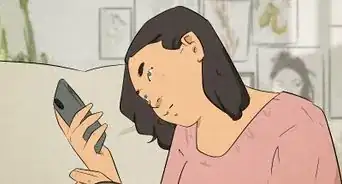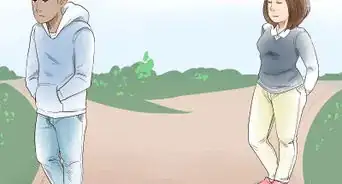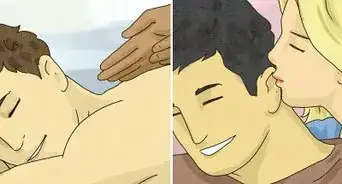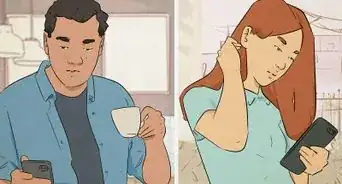This article was co-authored by Liana Georgoulis, PsyD and by wikiHow staff writer, Madeleine Criglow. Dr. Liana Georgoulis is a Licensed Clinical Psychologist with over 10 years of experience, and is now the Clinical Director at Coast Psychological Services in Los Angeles, California. She received her Doctor of Psychology from Pepperdine University in 2009. Her practice provides cognitive behavioral therapy and other evidence-based therapies for adolescents, adults, and couples.
There are 7 references cited in this article, which can be found at the bottom of the page.
This article has been viewed 32,682 times.
Are you in an anxious-avoidant relationship? Dating someone with a different attachment style than you can be confusing and isolating, so it's understandable if you're looking for guidance. Thankfully, this article is here to help. We'll give you everything you need to know about attachment styles in romantic relationships and we'll also cover all the signs that you're in an anxious-avoidant relationship. Then, we'll go into how you can change your relationship for the better to make it more healthy and fulfilling.
Steps
Signs of an Anxious-Avoidant Relationship
-
1One partner needs more attention, while the other feels smothered. If you're the anxious partner in the relationship, you may crave more reassurance from your partner and feel hurt or unloved when they don't meet your needs. If you're the avoidant partner, you might feel like your partner is asking too much and get overwhelmed by their need for validation.[4]
- As an anxious partner, you may want to text throughout the day, while your avoidant partner may want space. This might make you feel like your partner doesn't care, when in reality, your partner just needs different things.
-
2One partner wants to talk things out, while the other withdraws. If you have anxious tendencies, you may need more vocal reassurance (especially if you sense something is wrong). If you're an avoidant partner, you might be uncomfortable with this level of intimacy and create more distance anytime you sense a fight coming.
- As an avoidant partner, you may dismiss your partner's need to talk things out and avoid difficult conversations. If you're an anxious partner, this distance might leave you feeling hurt and rejected.
-
3One partner feels taken for granted, while the other feels trapped. If you're an anxious partner in an anxious-avoidant relationship, you'll feel like your needs aren't being met. Since you're not getting the attention, validation, or intimacy you crave, you may end up feeling unhappy most of the time. If you're the avoidant partner, you'll feel overwhelmed by your anxious partner's attachment to you, and you might even feel stuck in the relationship despite your growing fears.
- As an anxious partner, you may sacrifice your own needs to make the relationship work or resort to passive-aggressive behavior to get your partner to stay. If you're an avoidant partner, this might make you feel trapped.[5]
Breaking the Cycle
-
1Understand how your own attachment style plays into this dynamic. Both anxious and avoidant partners can make positive changes if you make an effort to understand your behavior. Becoming aware of your own attachment style is the first step towards creating a more healthy relationship dynamic, as it will encourage you to do internal work and avoid taking out your feelings on your partner.[6]
- If you're anxious, analyze your feelings of fear and anxiety before you react. You might also try developing outside friendships, hobbies, and interests to help you avoid relying on your partner for all of your emotional needs.
- If you're avoidant, try to push yourself to be vulnerable with your partner. Though it may feel uncomfortable at first, opening up to them and relying on them will help you realize that it's not so scary.
-
2Communicate with each other openly and honestly. Once the two of you have identified your attachment styles, try to talk through each other's needs and meet each other in the middle. Though you both may be pushing yourself to develop healthier relationship styles, it will lessen the burden if the two of you seek to understand and accommodate each other's different needs.[7]
- If you're an anxious partner, try to relax and allow your partner some alone time when they need space. You might go hang out with a friend or call a family member in the meantime.
- If you're an avoidant partner, try to give your partner reassurance and express your needs out loud. You might say, "I love spending time with you and can't wait to see you tomorrow, but I think I need some alone time to recharge."
- Remaining passive and avoidant prevents issues from getting resolved.
-
3Empathize with each other to avoid taking things personally. As the two of you work on developing more secure attachment styles, both of you may slip up and fall into old habits. When this happens, show compassion for your partner and yourself. Remind yourself that you're both doing your best to strengthen your relationship and remember that your behavior is the result of past experiences (and not something to be taken personally).
- If your partner messes up, try to show compassion and remind them of all the progress they've made. You might say, "I understand that this is a tough process. I really appreciate all the work you've done so far."
- "I" statements are a great way to keep the conversation positive without sounding like you're blaming or commanding the other person.
- If you catch yourself falling into old habits, forgive yourself and keep trying. Changing your attachment style is hard work, and it takes time and practice to unlearn old behaviors.[8]
-
4Acknowledge what you love about your relationship. This will help both of you feel encouraged to keep trying and forge a healthier relationship together. Tell your partner why you're grateful to have them in your life, and let them know when their hard work is paying off.
- You might say something like, "I'm so grateful to have you in my life. No one makes me laugh like you" or "Thanks so much for giving me the space I need. I know it's been a big change, and it really means so much to me."
-
5Visit a couple's therapist. Developing a healthier attachment style and changing a relationship dynamic is hard work, especially if it's the result of childhood trauma. A therapist can help the two of you work through your past and better understand why you were drawn to an anxious-avoidant dynamic. They'll also give you tools to help develop a more secure bond or understand when it may be best to walk away.[9]
- If the two of you aren't comfortable seeing a couple's therapist, seeking out individual therapy can help you understand your own attachment style and navigate your relationship.
-
6Walk away if you're being mistreated or you're consistently unhappy. Anxious-avoidant relationships can absolutely work, but sometimes, you and your partner may just not be compatible. As tough as it may be, there are many factors that may indicate it would be healthy for you to leave your relationship. Taking this step can encourage you to strengthen your self-worth and find a partner that's able to meet your needs. Here are some signs it will be best to walk away:[10]
- You feel disrespected by your partner (this includes lying, manipulation, or cheating).
- Your partner engages in any form of emotional or physical abuse (this includes gaslighting, verbal insults, and physical harm of any kind).
- You feel consistently unhappy, unloved, or dissatisfied, no matter how much the two of you try to work things out.
References
- ↑ https://psychcentral.com/health/4-attachment-styles-in-relationships
- ↑ https://www.helpguide.org/articles/relationships-communication/attachment-and-adult-relationships.htm
- ↑ https://psychcentral.com/health/4-attachment-styles-in-relationships
- ↑ https://www.psychologytoday.com/us/blog/toxic-relationships/202008/attachment-woes-between-anxious-and-avoidant-partners
- ↑ https://www.psychologytoday.com/us/blog/toxic-relationships/202104/how-change-your-attachment-style-and-your-relationships
- ↑ https://greatergood.berkeley.edu/article/item/how_to_stop_attachment_insecurity_from_ruining_your_love_life
- ↑ https://www.psychologytoday.com/us/blog/toxic-relationships/202008/attachment-woes-between-anxious-and-avoidant-partners
- ↑ https://greatergood.berkeley.edu/article/item/how_to_stop_attachment_insecurity_from_ruining_your_love_life
- ↑ https://greatergood.berkeley.edu/article/item/how_to_stop_attachment_insecurity_from_ruining_your_love_life








































































